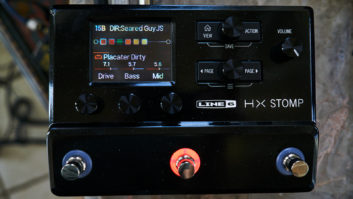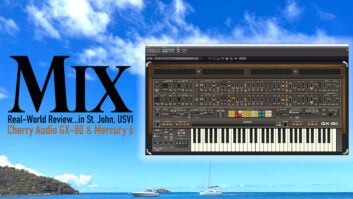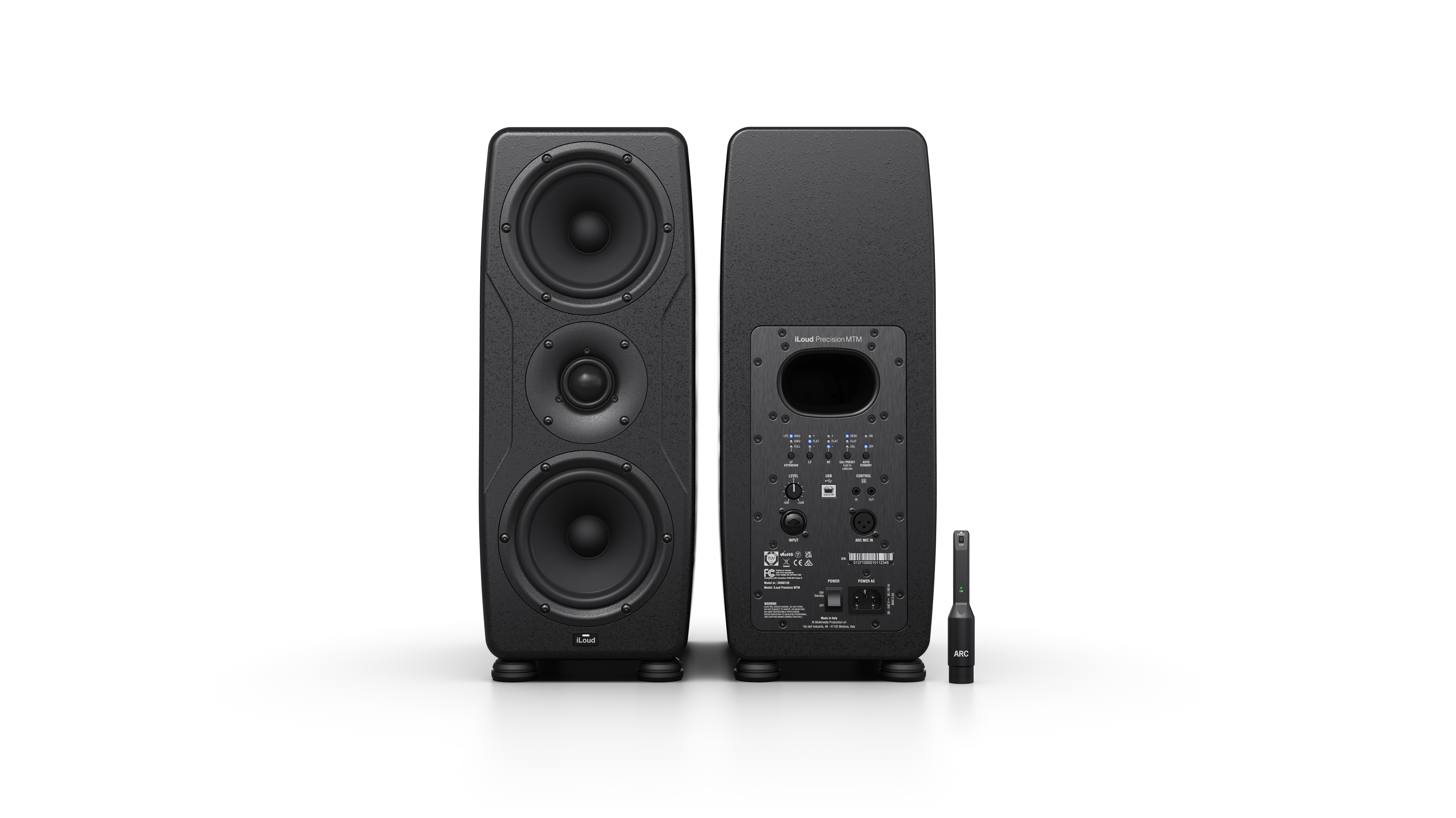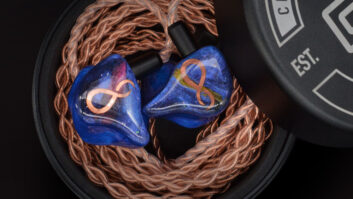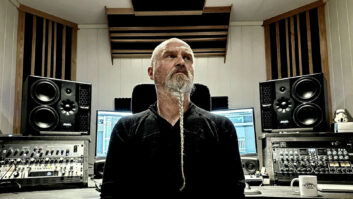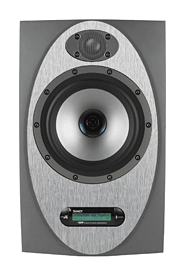
With studios, broadcasters and post houses hungry for “intelligent” speaker designs that can help tame an angry acoustical space and provide network ability, a range of manufacturers have jumped into the arena. Tannoy has always been a company with interesting ideas. Their Dual Concentric, phase-aligned design bowed in 1947 and is still at the center of their line. The focus of this test is the re-engineered Precision 6 iDP (Interactive Digital Programming), which offers a range of features including DSP, networking inteligence and Class D amps.
The new Precision 6 iDP is a three-way, active design with a 6-inch Dual Concentric (coaxial) driver combined with a 1-inch titanium-dome, neodymium-magnet SuperTweeter™ that extends response to 51 kHz, ±2 dB. TC Electronic teamed with Tannoy to provide the amplification and networking technology. Onboard are two 200-watt Class-D amps: one for the bass/midrange driver while the other provides powering for the tweeter (crossed at 1.9 kHz) and SuperTweeter (16kHz passive crossover). Max output is 117dB SPL at 1m.
Inputs are analog XLRs or 32 to 96k Hz AES/EBU digital, both routed to one “master” speaker and then distributed through the Cat-5/RJ45 networking system. The analog inputs can be replaced with an optional AES/EBU dual-input card, extending the sample rate to 192 kHz and providing enough inputs for a fully digital 7.1 system. A BNC word clock input is standard. The speakers are magnetically shielded for use near standard CRTs, and the enclosures are rear-ported, which could be an issue if installed too close to a boundary.
Two optional subs are available. I tested the 12-inch, 750W powered TS112 iDP, with 118dB max output. For more thump-de-thump, the dual-12 model, TS212 iDP, kicks out 124 dB. Bass management is configurable from 2.1 to 7.1, with facilities for multiple subs. LFE can be boosted up to 14 dB, polarity-reversed and phase-shifted in 5-degree increments from 0 to 180 degrees for room/placement compensation.
WANT CONTROL?
Networked speakers offer control, flexibility and the ability to make acoustic tweaks (gain/EQ/crossover) at the mix position. All parameters can be addressed from optional software or a 2×16 display (with associated Enter/Exit and cursor keys) on the master’s front baffle. The front panel keys were slightly inconvenient, as you must be near the speaker rather than at the listening position. Make sure you have the menu navigation chart nearby or you might turn on the pink noise with your ear next to the cone.
The remote software is much easier to use than the baffle controls; however, certain utility functions are only available from the front panel. Several remote software and hardware control options are offered. The iDP-SOFT and Precision iDP PC-iP ™software are PC-only, with the latter intended for “advanced installations,” providing even more bass management and parametric filter possibilities. The subwoofer settings for phase, gain, lowpass and polarity must be offered with the PC-iP software; they are not found in the iDP-SOFT version nor on the front panel. An optional iDP hardware remote can be used stand-alone — without the software — allowing fast access to three reference levels, four presets (out of 15 user and 17 factory presets), solo/mute and master volume for up to a 5.1 system.

Setup parameters are available from the front panel or remote software. Tannoy does not provide a calibration mic or any “sweep parameters” or “auto-calibration via pink noise” to analyze your particular acoustical space. “Room position” is set at the menu to apply boundary compensation for installation on a console, against a wall, in a corner, etc., but no graphs are included to tell you what’s actually happening at these settings. There’s an onboard pink-noise generator with a ±6dB range, but no explanation is given about how to calibrate your reference levels in SPL. A “relative level” adjustment range of 0 to -40 dB allows for a preset relative to the calibrated global level, but again, at what reference? Using an analog Radio Shack SPL meter, I measured 85dBA SPL at 1m with the generator set at the default, 0.0 dB. Bass and treble can be adjusted by ±6 dB, but no curves or shelving characteristics are described beyond that.
Using an RTA showed that bass is a low shelf, starting around 160 Hz. Treble is a high shelf with the knee somewhere between 3.5 and 4 kHz. Both filters sounded good, adding a little more low-end body and a nice sheen on the top. In my room, these were unnecessary — running flat was just fine. It would be nice to have this data close by without jumping through hoops to get it. If you are mixing for film, ANSI and SMPTE 222M variations of the X-Curve are included, along with charts for both.
DIGITALLY YOURS
The AES digital inputs are selectable via software or the front panel switches. Input selection and speaker setup (including reference levels) are not saved with presets, so switching between inputs and matching levels can be cumbersome and definitely not immediate enough for making A/B comparisons. I found the converters (24-bit, dual-bit delta sigma) slightly lacking in depth and soundstage as compared to other converters in a similar or even lesser price range. The imaging became somewhat flat. There was a particular emphasis of the upper harmonics in the vocal range, making vocal tracks slightly edgy.
Heavy midrange material, such as metal guitars, were not well-defined. I used my Alesis Masterlink’s converters for reference by sending the converted analog output to the Tannoys while simultaneously sending the digital AES output signal to the Tannoy AES inputs, and A/B’d the two sources. For another test, I sent S/PDIF from a Digidesign 002 Rack to the Masterlink (to “convert” to a balanced AES signal), again taking the AES output to the Tannoys, with the analog input coming from the analog output of the 002. After a great deal of listening, I always returned to the outboard converters, which reproduced more separation between the instruments and less brilliance on vocal tracks.
PUMP UP THE VOLUME
On first listen using the Masterlink’s converters, the speakers sounded great. I tested the Tannoy Precision 8Ds last year (February 2006 issue) and felt they had too much top end and not enough punch. That’s all changed, thanks to the redesign of the SuperTweeter and the added subwoofer. The imaging is stellar, with a wide sweet spot. The top end is beautifully smooth and accurate. The low end fills out nicely, with compressed, master references sounding truly exceptional.
On raw tracks coming out of the 002, everything I threw at the Precision 6 iDPs had a deep, 3-D quality. Acoustic guitars, piano, male/female vocals, drums/percussion, electric rhythm guitar, lead guitar, bass, sax, violins and trumpets were all reproduced with subtle details and a solid soundstage. One particular nylon-string acoustic guitar track was extremely detailed. You could easily hear the nuances and variations of tone from the pad of the fingers to the bite and percussion of the nail. Articulation is very up front without becoming edgy or exhibiting splatter. There’s a pronounced forward midrange, between 800 and 1.25k Hz, with the associated first harmonics also emphasized, bringing vocals forward in the mix. This was in comparison to my main reference speakers (JBL LSR6328P/6312P) and verified with a RTA. And even after using these speakers for a prolonged period of time, I didn’t notice any ear fatigue — another great feature.
AND IN THE END
What these speakers lack in auto-room calibration and basic calibration documentation, they certainly make up for with exceptional reproduction. Those with the dough should give these a listen, but all this technology comes with a fairly hefty price tag: $7,066 for a 2.1 system; a 5.1 surround rig lists at $12,870 with software, remote and digital card. Prices: Precision 6D iDP master, $2,185; slave, $1,696; TS112 iDP subwoofer, $3,185; iDP-SOFT, $171; iDP remote, $295; AES digital input card, $250.
Tannoy North America, 519/745-1158, www.tannoy.com.
Bobby Frasier is a pro audio consultant and educator in Phoenix.
